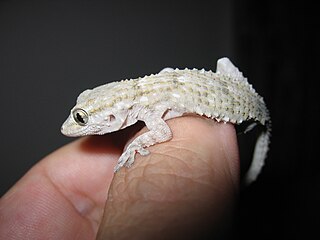
Tarentola is a genus of geckos, commonly known as wall geckos.

The earless skinks form the genus Hemiergis in the skink family Scincidae. All earless skinks are native to Australia.

Mochlus is a genus of skinks, lizards in the family Scincidae. The genus is endemic to Africa.

Oligosoma is a genus of small to medium-sized skinks found only in New Zealand as well as Norfolk and Lord Howe islands. Oligosoma had previously been found to belong to the Eugongylus group of genera in the subfamily Lygosominae; the Australian genus Bassiana appears to be fairly closely related.
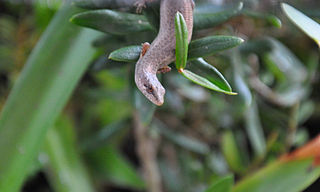
Saproscincus is a genus of skinks native to Australia, sometimes referred to as shadeskinks. It contains the following species:

George Albert Boulenger was a Belgian-British zoologist who described and gave scientific names to over 2,000 new animal species, chiefly fish, reptiles, and amphibians. Boulenger was also an active botanist during the last 30 years of his life, especially in the study of roses.
Ophiomorus tridactylus, commonly known as the three-toed snake skink, is a species of skink endemic to sandy desert areas of South Asia. It is also called the Indian sand-swimmer for its habit of moving just under the sand.

Sphenomorphus dussumieri, commonly known as Dussumier's forest skink, is a species of skink, a lizard in the family Scincidae. The species is endemic to southern India.

Chalcides colosii, also known as the Colosi's cylindrical skink, is a moderately-sized species of skink found in Morocco and some Spanish territories. It is named after Giuseppe Colosi, former director of the Zoological Institute of the University of Florence. It was once considered a subspecies of Chalcides ocellatus. The females of the species give birth to live young.
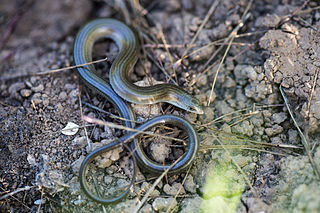
Chalcides guentheri, or Günther's cylindrical skink, is a species of skink, a lizard in the family Scincidae. The species is endemic to the Near East.
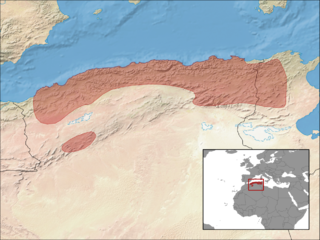
The Algerian three-toed skink is a species of "grass-swimming" skink with an elongated serpentine shape and reduced limbs. It is endemic to north-western Africa.

The West Canary skink, also known commonly as the Canaryan cylindrical skink, East Canary Islands skink, the Tenerife skink, is a species of lizard in the family Scincidae. The species is endemic to the Canary Islands.
The wedge-snouted skink is a common and widespread species of skink in the family Scincidae. It is found in Egypt, Israel, Jordan, Libya, and the Palestinian territories. Its natural habitats are subtropical or tropical dry shrubland, subtropical or tropical dry lowland grassland, freshwater springs, hot deserts, and sandy shores. S. sepsoides is a viviparous species, and it is nocturnal during the summer and diurnal during the winter.
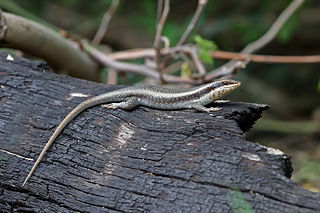
Trachylepis is a skink genus in the subfamily Lygosominae found mainly in Africa. Its members were formerly included in the "wastebin taxon" Mabuya, and for some time in Euprepis. As defined today, Trachylepis contains the clade of Afro-Malagasy mabuyas. The genus also contains a species from the Brazilian island of Fernando de Noronha, T. atlantica, and may occur in mainland South America with Trachylepis tschudii and Trachylepis maculata, both poorly known and enigmatic. The ancestors of T. atlantica are believed to have rafted across the Atlantic from Africa during the last 9 million years.
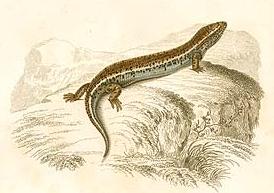
Chalcides ocellatus, or the ocellated skink is a species of skink found in Greece, southern Italy, Malta, and parts of northern Africa. UAE, Israel, It is also found in Pakistan, India and Sri Lanka.
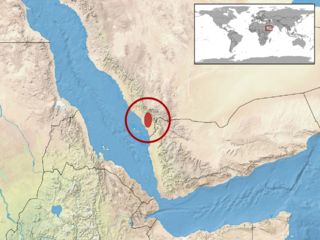
Chalcides levitoni, commonly called Leviton's cylindrical skink, is a species of lizard in the family Scincidae. The species is endemic to Saudi Arabia.

Scincinae is a subfamily of lizards. The subfamily contains 33 genera, and the genera contain a combined total of 284 species, commonly called skinks. The systematics is at times controversial. The group is probably paraphyletic. It is one of three subfamilies of the family Scincidae, the other two being Acontinae and Lygosominae.

Chalcides sphenopsiformis, or Duméril's wedge-snouted skink, is a species of lizard in the family Scincidae. The species is found in Morocco, Western Sahara, Mauritania, and Senegal.
















